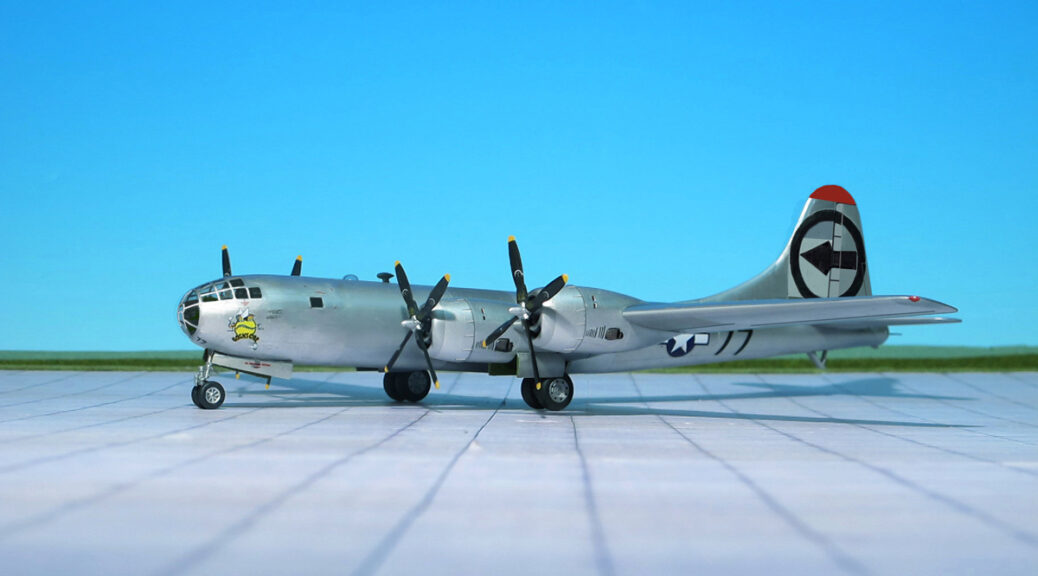After the Nagasaki Mission the circle R tail marking of the 6th Bombardment Group, 313th Bomb Wing tail marking was changed to that of the 509th Composite Group, circle outline around an arrowhead pointing forward. At last the Nose Art „Bockscar“ was painted backboard side, Victor # 77 remained unchanged,
After the war, Bockscar returned to the United States in November 1945. In September 1946, it was given to the National Museum of the United States Air Force at Wright-Patterson Air Force Base, Ohio. The aircraft was flown to the museum on 26 September 1961, and its original markings were restored (nose art was added after the mission). Bockscar is now on permanent display at the National Museum of the United States Air Force, Dayton, Ohio, next to a replica of the Fat Man atomic bomb.
PLANS FOR MORE ATOMIC ATTACKS ON JAPAN
Major General Leslie R. Groves expected to have another “Fat Man” atomic bomb ready for use on 19 August, with three more in September and a further three in October; a second Little Boy bomb (using U-235) would not be available until December 1945. On 10 August, he sent a memorandum to General of the Army Georg C. Marshall in which he wrote that “the next bomb … should be ready for delivery on the first suitable weather after 17 or 18 August.” Marshall endorsed the memo with the hand-written comment, “It is not to be released over Japan without express authority from the President”, something President Harry S. Truman had requested that day. This modified the previous order that the target cities were to be attacked with atomic bombs “as made ready”. There was already discussion in the War Department about conserving the bombs then in production for Operation Downfall, and Marshall suggested to Secretary of War Henry L. Stimson that the remaining cities on the target list be spared attack with atomic bombs.
Two more Fat Man assemblies were readied, and scheduled to leave Kirtland Field, New Mexico, for Tinian on 11 and 14 August, and Tibbets was ordered by Major General Curtis LeMay to return to Albuquerque, New Mexico, to collect them. At Los Alamos, New Mexico, technicians worked 24 hours straight to cast another plutonium core. Although cast, it still needed to be pressed and coated, which would take until 16 August. Therefore, it could have been ready for use on 19 August. Unable to reach Marshall, Groves ordered on his own authority on 13 August that the core should not be shipped.
On Marshall’s orders, Major General John E. Hull looked into the tactical use of nuclear weapons for the invasion of the Japanese home islands, even after the dropping of two strategic atomic bombs on Japan (Marshall did not think that the Japanese would capitulate immediately). Colonel Lyle E. Seeman reported that at least seven Fat Man-type plutonium implosion bombs would be available by X-Day, which could be dropped on defending forces. Seeman advised that American troops not enter an area hit by a bomb for “at least 48 hours”; the risk of nuclear fallout was not well understood, and such a short time after detonation would have exposed American troops to substantial radiation.
Ken Nicols, the District Engineer of the Manhattan Engineer District, wrote that at the beginning of August 1945, “planning for the invasion of the main Japanese home islands had reached its final stages, and if the landings actually took place, we might supply about fifteen atomic bombs to support the troops.” An air burst 1,800–2,000 ft above the ground had been chosen for the (Hiroshima) bomb to achieve maximum blast effects, and to minimize residual radiation on the ground, as it was hoped that American troops would soon occupy the city (Ref.: 24).






